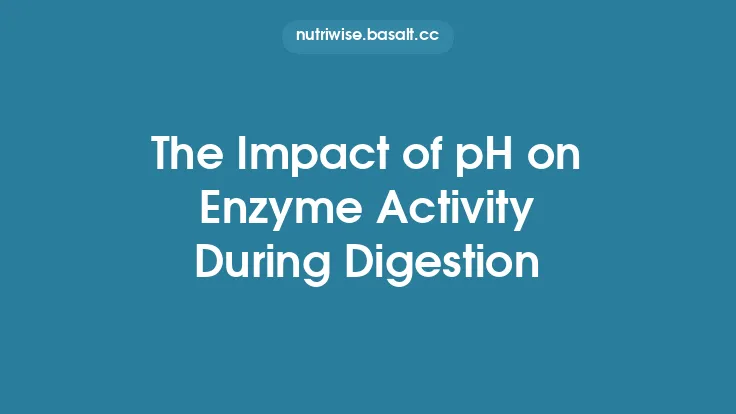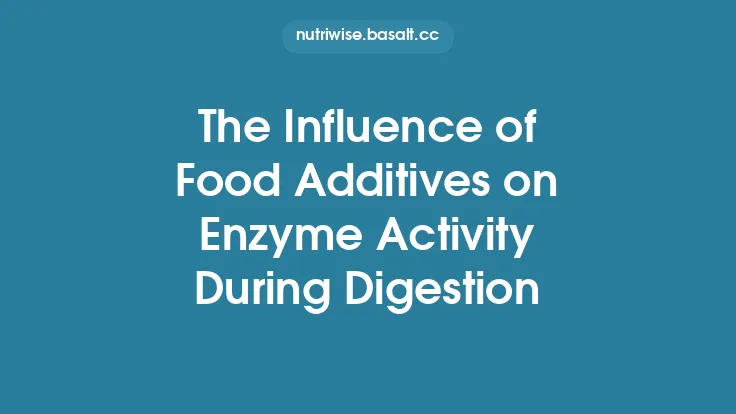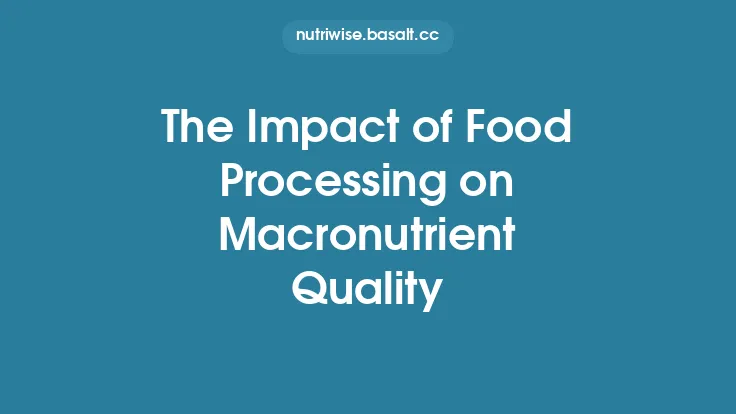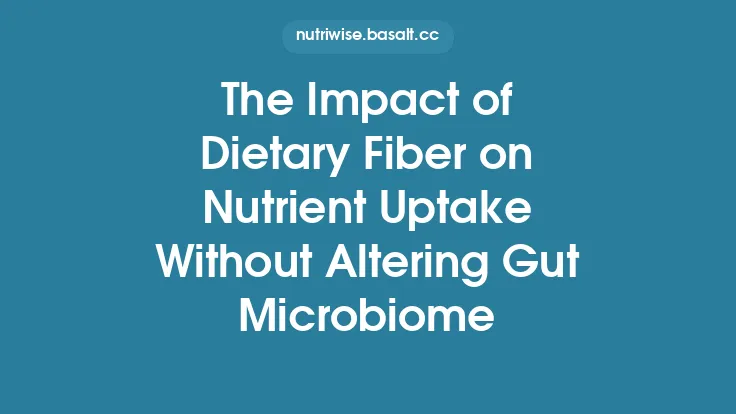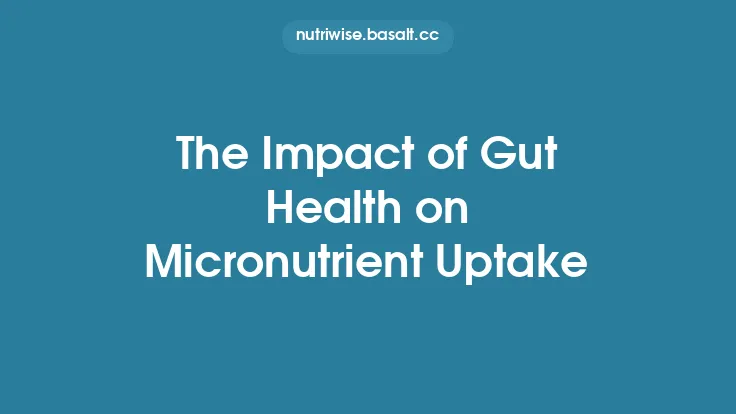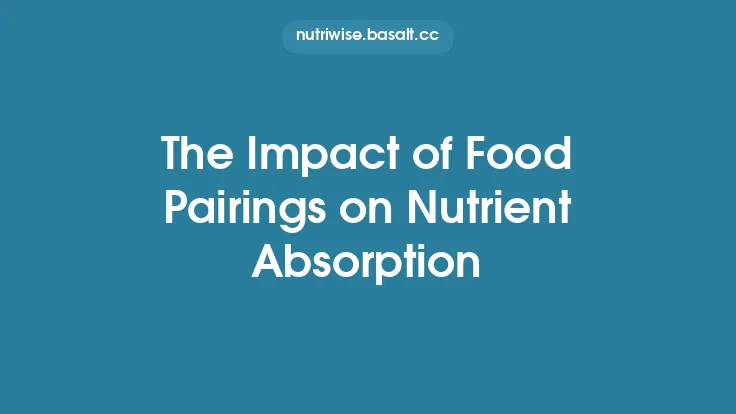Dietary antioxidants are a diverse group of phytochemicals and endogenous compounds that protect biological systems from oxidative damage. While their role in neutralizing free radicals is well‑known, an equally important but less frequently highlighted function is their influence on enzyme cofactors—molecules that are essential for catalytic activity. Enzyme cofactors can be metal ions (e.g., Fe, Cu, Mn, Zn), organic prosthetic groups (e.g., flavin adenine dinucleotide [FAD], nicotinamide adenine dinucleotide [NAD⁺]), or complex organic structures such as coenzyme Q10. The integrity, redox state, and availability of these cofactors determine the efficiency of countless metabolic pathways, from energy production to DNA repair. Understanding how dietary antioxidants interact with these cofactors provides insight into the broader network of nutrient‑nutrient interactions that sustain health.
1. Classification of Dietary Antioxidants Relevant to Cofactor Function
| Category | Representative Compounds | Primary Chemical Features | Typical Food Sources |
|---|---|---|---|
| Polyphenols | Flavonoids (quercetin, catechin), phenolic acids (caffeic acid) | Multiple hydroxyl groups, conjugated aromatic rings | Berries, tea, cocoa, onions |
| Carotenoids | β‑carotene, lycopene, lutein | Polyene chain with conjugated double bonds | Carrots, tomatoes, leafy greens |
| Vitamin‑derived antioxidants | Vitamin E (α‑tocopherol), Vitamin A (retinol) | Lipophilic chromanol or retinoid structures | Nuts, seeds, liver, dairy |
| Endogenous antioxidants (diet‑derived precursors) | Glutathione precursors (N‑acetylcysteine), selenium (as selenomethionine) | Sulfur‑containing amino acids, seleno‑amino acids | Cruciferous vegetables, Brazil nuts |
| Organic acids | Ascorbic acid (vitamin C), α‑lipoic acid | Redox‑active carbonyl groups | Citrus fruits, organ meats |
Although vitamin C is a classic antioxidant, its discussion here is limited to its general redox capacity and not to any specific synergy with iron absorption, which falls outside the scope of this article.
2. Mechanistic Pathways of Antioxidant–Cofactor Interactions
2.1 Direct Redox Protection of Metal‑Containing Cofactors
Many enzymes rely on metal ions that cycle between oxidation states during catalysis (e.g., Fe²⁺/Fe³⁺ in cytochrome P450, Cu⁺/Cu²⁺ in superoxide dismutase). Reactive oxygen species (ROS) can oxidize these metals beyond their functional range, leading to loss of activity or irreversible damage. Lipophilic antioxidants such as vitamin E embed in membranes and scavenge lipid peroxyl radicals, thereby preserving the redox environment around membrane‑bound metal cofactors. Water‑soluble polyphenols can chelate transition metals, forming stable complexes that prevent Fenton‑type reactions while still allowing the metal to participate in enzymatic turnover.
2.2 Modulation of Cofactor Biosynthesis Pathways
The synthesis of several organic cofactors requires redox‑sensitive enzymes. For instance, the conversion of riboflavin to FAD involves flavin‑dependent oxidoreductases that are themselves protected by intracellular antioxidants. Dietary polyphenols can up‑regulate the expression of genes encoding these biosynthetic enzymes via activation of the Nrf2‑ARE (antioxidant response element) pathway, thereby enhancing the cellular pool of functional cofactors.
2.3 Recycling of Oxidized Cofactors
Cofactors such as NAD⁺ and coenzyme Q10 undergo reversible oxidation during metabolic cycles. Antioxidants accelerate the reduction of their oxidized forms. α‑Lipoic acid, for example, can directly reduce oxidized NAD⁺ to NADH, while also regenerating reduced glutathione, which in turn participates in the reduction of coenzyme Q10. This recycling maintains a high turnover rate for oxidative phosphorylation and β‑oxidation.
2.4 Allosteric and Structural Stabilization
Some antioxidants bind to enzyme surfaces away from the active site, stabilizing the protein’s tertiary structure and preserving the proper orientation of bound cofactors. Molecular docking studies have shown that quercetin can interact with the peripheral subunits of mitochondrial complex I, reducing conformational fluctuations that would otherwise expose the flavin mononucleotide (FMN) cofactor to solvent oxidation.
3. Antioxidant Effects on Specific Metal‑Containing Cofactors
3.1 Iron‑Sulfur (Fe‑S) Clusters
Fe‑S clusters are integral to electron transport chains, DNA repair enzymes, and metabolic dehydrogenases. Their high reactivity makes them vulnerable to oxidative disassembly. Polyphenols such as epigallocatechin‑3‑gallate (EGCG) can donate electrons to oxidized Fe‑S clusters, restoring their functional state. Moreover, the mild chelating ability of flavonoids prevents free iron from catalyzing deleterious radical formation without stripping iron from the cluster.
3.2 Copper‑Containing Enzymes
Copper enzymes (e.g., cytochrome c oxidase, dopamine β‑hydroxylase) require a precise Cu⁺/Cu²⁺ balance. Lipophilic carotenoids have been shown to protect mitochondrial copper centers by reducing lipid peroxidation, which otherwise leads to copper release and mis‑metallation. Additionally, certain polyphenols can act as copper chaperones, delivering Cu⁺ to apo‑enzymes in a controlled manner.
3.3 Manganese‑Dependent Superoxide Dismutase (Mn‑SOD)
Mn‑SOD is a primary defense against mitochondrial superoxide. Dietary antioxidants that localize to the mitochondrial matrix (e.g., coenzyme Q10, α‑lipoic acid) preserve the Mn²⁺ oxidation state, ensuring rapid dismutation of superoxide. Experimental models demonstrate that supplementation with these antioxidants increases Mn‑SOD activity by up to 30 % through both direct protection and transcriptional up‑regulation.
3.4 Zinc‑Dependent Enzymes
Zinc acts as a structural cofactor in numerous transcription factors and enzymes (e.g., carbonic anhydrase). While zinc does not undergo redox cycling, oxidative stress can cause zinc release from proteins, leading to cellular zinc deficiency. Antioxidants that limit ROS generation indirectly maintain zinc binding integrity. Moreover, selenium‑containing antioxidants (e.g., selenomethionine) can modulate the expression of zinc‑transport proteins, supporting homeostasis.
4. Influence on Non‑Metal Organic Cofactors
4.1 Flavin Adenine Dinucleotide (FAD) and Flavin Mononucleotide (FMN)
FAD/FMN are derived from riboflavin and serve as redox carriers in dehydrogenases. Their isoalloxazine ring is susceptible to oxidative degradation. Vitamin E and carotenoids, by reducing the surrounding lipid peroxidation, protect the flavin moiety from oxidative cleavage. In vitro assays reveal that the presence of α‑tocopherol reduces FAD oxidation rates by ~40 % under high‑ROS conditions.
4.2 Nicotinamide Adenine Dinucleotide (NAD⁺/NADH)
The NAD⁺/NADH pair is central to glycolysis, the TCA cycle, and oxidative phosphorylation. Oxidative stress can shift the NAD⁺/NADH ratio toward a more oxidized state, impairing metabolic flux. α‑Lipoic acid and certain polyphenols act as NAD⁺‑reducing agents, restoring the NAD⁺/NADH balance. This effect is especially relevant in tissues with high metabolic demand, such as skeletal muscle and brain.
4.3 Coenzyme Q10 (Ubiquinone/Ubiquinol)
Coenzyme Q10 shuttles electrons within the mitochondrial inner membrane and also functions as a lipid‑soluble antioxidant. Dietary intake of ubiquinol (the reduced form) directly supplements the antioxidant pool, while polyphenols can enhance the activity of the enzyme quinone‑reductase, facilitating the conversion of ubiquinone to ubiquinol. This dual role reinforces both electron transport efficiency and membrane protection.
5. Antioxidant Modulation of Cofactor Biosynthesis and Recycling
The biosynthetic pathways for many cofactors intersect with antioxidant signaling networks. For example:
- Riboflavin Kinase Regulation: Nrf2 activation by dietary polyphenols up‑regulates riboflavin kinase, increasing intracellular FAD levels.
- NAD⁺ Salvage Pathway: Nicotinamide phosphoribosyltransferase (NAMPT) expression is enhanced by resveratrol, boosting NAD⁺ synthesis from nicotinamide.
- Selenoprotein Synthesis: Selenium‑rich foods provide the substrate for selenocysteine incorporation into glutathione peroxidase, a key antioxidant enzyme that also protects cofactor integrity.
These regulatory effects illustrate how antioxidants can act upstream, ensuring a sufficient supply of functional cofactors for downstream enzymatic reactions.
6. Redox‑Sensitive Enzyme Regulation by Antioxidants
Enzymes that contain redox‑active cysteine residues (e.g., thioredoxin reductase, glutaredoxin) are directly modulated by the cellular redox environment. Antioxidants maintain these cysteines in a reduced state, preserving enzyme activity. In turn, these enzymes participate in the reduction of oxidized cofactors such as disulfide‑linked NADP⁺ or oxidized glutathione, creating a feedback loop that sustains metabolic homeostasis.
7. Dietary Sources, Bioavailability, and Practical Considerations
| Antioxidant | Key Food Sources | Bioavailability Factors | Interaction with Cofactors |
|---|---|---|---|
| Quercetin | Apples, onions, capers | Enhanced by citrus flavanones; limited by glucuronidation | Protects Fe‑S clusters; chelates Cu²⁺ |
| β‑Carotene | Carrots, sweet potatoes | Fat‑soluble; requires dietary lipids for absorption | Shields membrane‑bound Mn‑SOD |
| α‑Tocopherol | Almonds, sunflower seeds | Requires dietary fat; transported via lipoproteins | Prevents lipid peroxidation of FAD‑containing enzymes |
| α‑Lipoic Acid | Spinach, organ meats | Both water‑ and lipid‑soluble; crosses blood‑brain barrier | Reduces oxidized NAD⁺/NADH |
| Selenium (as selenomethionine) | Brazil nuts, seafood | Protein‑bound; high absorption efficiency | Supports glutathione peroxidase, protecting cofactor pools |
When planning a diet to support cofactor function, it is advisable to combine antioxidant‑rich foods with appropriate macronutrients that facilitate their absorption (e.g., pairing carotenoids with healthy fats). Additionally, moderate cooking methods (steaming, light sautéing) preserve polyphenol content while improving bioavailability.
8. Clinical and Research Implications
- Metabolic Disorders: Impaired antioxidant status is linked to dysregulated cofactor pools in diabetes and metabolic syndrome. Supplementation with α‑lipoic acid has shown improvements in NAD⁺/NADH ratios and mitochondrial enzyme activities.
- Neurodegeneration: Oxidative damage to Fe‑S clusters in complex I is a hallmark of Parkinson’s disease. Dietary flavonoids that protect these clusters may slow disease progression, a hypothesis currently under clinical investigation.
- Aging: Age‑related decline in coenzyme Q10 and glutathione levels can be mitigated by combined antioxidant strategies, preserving mitochondrial function and reducing sarcopenia risk.
Emerging research employing metabolomics and redox proteomics is beginning to map the precise alterations in cofactor oxidation states in response to dietary antioxidant interventions, offering a more granular understanding of nutrient‑nutrient interplay.
9. Future Directions and Knowledge Gaps
- Quantitative Kinetics: While qualitative protection is established, quantitative rate constants for antioxidant‑mediated reduction of specific oxidized cofactors remain scarce.
- Individual Variability: Genetic polymorphisms in antioxidant‑responsive transcription factors (e.g., Nrf2) may influence how effectively dietary antioxidants sustain cofactor pools.
- Synergistic Formulations: Investigating optimal combinations of antioxidants (e.g., polyphenol‑carotenoid blends) that target multiple cofactor classes simultaneously.
- Long‑Term Clinical Trials: Most existing studies are short‑term; extended trials are needed to assess whether sustained antioxidant intake translates into measurable improvements in cofactor‑dependent metabolic outcomes.
10. Practical Recommendations for Optimizing Antioxidant‑Cofactor Interactions
- Diversify Antioxidant Sources: Aim for a colorful plate that includes berries, leafy greens, nuts, and cruciferous vegetables to cover a broad spectrum of polyphenols, carotenoids, and vitamin E.
- Pair with Healthy Fats: Incorporate olive oil, avocado, or fatty fish to enhance absorption of fat‑soluble antioxidants that protect membrane‑bound cofactors.
- Consider Targeted Supplementation: In populations at risk of deficiency (e.g., older adults, individuals with chronic oxidative stress), supplements such as α‑lipoic acid (300–600 mg/day) or coenzyme Q10 (100–200 mg/day) may provide additional support.
- Monitor Redox Biomarkers: Periodic assessment of plasma glutathione, oxidized/reduced NAD⁺ ratios, and lipid peroxidation markers can guide dietary adjustments.
- Limit Pro‑Oxidant Exposures: Reduce intake of processed foods high in trans‑fats and limit exposure to environmental pollutants that overwhelm antioxidant defenses, thereby preserving cofactor integrity.
By integrating these strategies, individuals can harness the protective capacity of dietary antioxidants to maintain the functional integrity of enzyme cofactors, supporting optimal metabolic performance throughout the lifespan.
